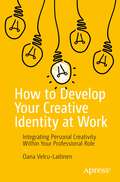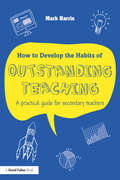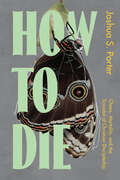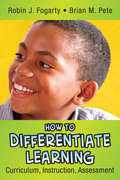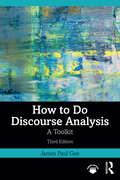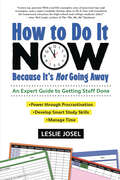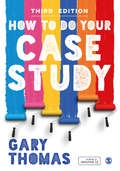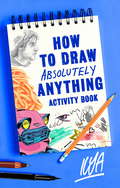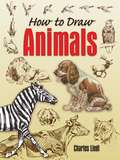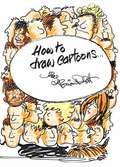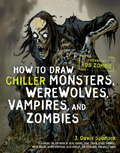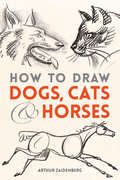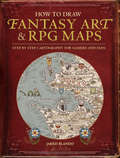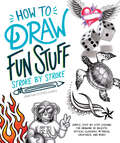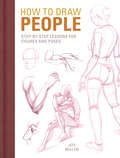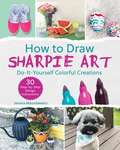- Table View
- List View
How to Develop Your Creative Identity at Work: Integrating Personal Creativity Within Your Professional Role
by Oana Velcu-LaitinenAccording to the World Economic Forum, creativity is considered to be the third-most-important skill for employees, behind complex problem-solving and critical thinking. This book will help you rethink your creativity and its value in the work life, giving you access to intellectual, emotional, and reputational benefits that were previously unattainable. Based on a collection of interviews and research, this book translates the latest findings on the creative beliefs, confidence, and mindset into digestible thoughts for experts with an itch for improvement and innovation in domains like technology, entrepreneurship, and education. It brings a new perspective to creativity by focusing on how individuals can understand their creativity and what the implications are on what they want to achieve. How to Develop Your Creative Identity at Work is based on the most recent creativity research, which analyzes how creativity plays an important part in the individual's sense of identity. What You'll LearnUnderstand how personal beliefs about the innate creativity are influenced by past experiencesSee how the creator's personality can be shaped through new habits of curiosity, emotional risk-taking and insightEstablish a creative communication style that enables others to navigate smoothly through the challenging moments in a feedback conversationBecome an ambitious person with a sense of meaning in the work you do Identify all the familiar and less familiar in-house creative experts Who This Book Is ForThe primary reader is a knowledgeable expert, in a creative or less creative role, who is curious to bring a better fit between their inner experiences and the external environment. The secondary audience are the experts in roles like learning and development, people and culture change, and team leads who are interested in facilitating a space where employees feel safe to share their original ideas and express their curiosity.
How to Develop a Professional Portfolio: A Manual for Teachers
by Dorothy M. Campbell Pamela Bondi Cignetti Beverly J. Melenyzer Diane Hood NettlesThis reference book will guide the reader in creating a teaching portfolio that is both functional and impressive when shown in a job interview. The end product will be centered around the teaching standards that candidates need to have knowledge of in the job market today.
How to Develop the Habits of Outstanding Teaching: A practical guide for secondary teachers
by Mark HarrisThere can arguably be no greater influence on a person’s life than their education, and it is the classroom practice of teachers that helps to shape young lives. How to Develop the Habits of Outstanding Teaching aims to help teachers improve their teaching habits and practice so that every student can be supported, challenged and inspired to achieve their ambitions and goals. Providing a step-by-step guide to the key components for creating outstanding lessons, the book includes a wealth of strategies and techniques that are easy to implement and will have an immediate impact on your teaching and students. With a wide range of examples and case studies taken from different subjects, the book covers all aspects of teaching including: how to create independence, resilience and creativity; tried and test techniques for differentiation and questioning; habits and hacks to manage your time effectively; ideas on how you can coach yourself to ‘outstanding’; Memory techniques for students; literacy in lessons; marking and homework. Ideal for newly qualified teachers, as well as more experienced teachers who are looking for some fresh ideas for their lessons, this highly practical resource will instil the habits that will enable you to perform at an outstanding level consistently in the classroom.
How to Die: Chaos, Mortality, and the Scandal of Christian Discipleship
by Joshua S. PorterAnyone disenchanted with institutionalized religion and desperate for something real will welcome this subversive book&’s call to abandon performative faith and rediscover the radical way of Jesus. This isn&’t another feel-good Christian book—it&’s an unfiltered, unapologetic guide to dying to yourself. Blending storytelling, raw liturgy, and counter-cultural faith, Joshua Porter rips through the safe, sanitized versions of Christianity and reclaims the gritty, disruptive truth of the gospel. How to Die weaves together biblical narrative, ancient creeds, and personal story in a way that dares us to reconsider what it means to follow Jesus. This book isn&’t here to affirm what you already know. It&’s here to wreck your assumptions, shake your faith, and challenge you to follow Jesus beyond disillusionment and into authentic discipleship.
How to Differentiate Learning: Curriculum, Instruction, Assessment
by Brian M. Pete Robin J. FogartyLearn how to boost students' success with a differentiated instructional approach!The authors introduce the elements of the differentiated learning model and provide ways for educators to teach to the brain by considering student readiness levels, interests, and learning styles as they design instruction for K–12 classrooms. You will find guidelines and approaches for adjusting the curriculum, lessons, or assessments to offer entry points for all students. This practical text examines ways to:Prepare for differentiated instructionIdentify students' individual needsEngage students with cooperative learning and inquiry-based lessonsDevelop differentiated curriculum and assessment models
How to Do Discourse Analysis: A Toolkit
by James Paul GeeHow to Do Discourse Analysis provides a comprehensive toolkit for conducting discourse analysis, offering 26 practical tools to examine how language is used to construct meaning, enact identities, and shape social realities. Written by renowned linguist James Paul Gee, it introduces key concepts like situated meanings, social languages, and Discourses, showing how language both reflects and creates social contexts.This essential textbook takes readers through a step-by-step process of analyzing texts and talk, from examining grammar and vocabulary to uncovering underlying ideologies and power dynamics. It covers a wide range of discourse types, from everyday conversations to political speeches and social media posts. Gee draws on diverse examples from education, politics, media, and popular culture to illustrate the tools in action.While grounded in linguistic theory, the book emphasizes hands-on application. Each tool is accompanied by sample analyses and practice exercises. This new edition incorporates recent developments in digital communication and updates examples for contemporary relevance, making it an ideal resource for advanced undergraduate and postgraduate students working in the areas of applied linguistics, education, psychology, anthropology, and communication.
How to Do It Now Because It's Not Going Away: An Expert Guide to Getting Stuff Done
by Leslie JoselWith distance learning, teens are having to manage their time and attention now more than ever. Procrastination is especially tough for young adults. Getting started is overwhelming, it's hard to get motivated, not knowing how long things take messes up planning, and distractions are everywhere. We are all wired to put things off, but we can learn tools and techniques to kick this habit. This book is a user-friendly guide to help teens get their tasks done. Simple, straightforward, and with a touch of humor, it's packed with practical solutions and easily digestible tips to stay on top of homework, develop a sense of time, manage digital distractions, create easy-to-follow routines, and get unstuck. In her breezy, witty style, internationally recognized academic and parenting coach Leslie Josel opens the door to a student's view of procrastination, dives deep into what that really looks like, and offers up her Triple Ts—tips, tools and techniques—to teach students how to get stuff done…now. "Hey Guys! This book is the easiest and fastest way for you to learn how to help yourself. If your parents are constantly on you about school stuff, how you manage your time or things like that you'll definitely want to use this book." — Ryan Wexelblatt, LCSW (ADHD Dude) "Listen up, parents! This is the book that will get teens nodding their heads—and actually using the strategies and tips as they transform their study time! Teens and college students alike will feel totally empowered as they tackle their toughest obstacles: procrastination, distraction, organization, and all the rest. With real-life examples and a super-readable format, students will gain the practical help they need to power through their studies and do their best work." Amy McCready, author of The "Me, Me, Me" Epidemic: A Step-by-Step Guide to Raising Capable, Grateful Kids in an Over-Entitled World
How to Do Your Case Study
by Gary ThomasThis accessible guide takes you through the process of designing, conducting and writing up a research project using case study methods. In his characteristic warm and friendly style, Gary Thomas covers each step at a confidence-building pace, helping you to get to grips with the theory and practice of doing a case study. Focusing on vital issues like validity, reliability and quality in research, the author helps you ensure your research is rigorous and methodologically sound. This third edition: · Offers an expanded discussion of key ethical issues in case study research · Provides up to date information about using social media in research · Presents a new navigation tool to help you plan your case study project · Enables you to develop the skills you need to become a critical and reflexive researcher Covering international examples of case study in practice and accompanied by downloadable checklists and templates, this book is the perfect companion to help you successfully complete a case study.
How to Do Your Case Study
by Gary ThomasThis accessible guide takes you through the process of designing, conducting and writing up a research project using case study methods. In his characteristic warm and friendly style, Gary Thomas covers each step at a confidence-building pace, helping you to get to grips with the theory and practice of doing a case study. Focusing on vital issues like validity, reliability and quality in research, the author helps you ensure your research is rigorous and methodologically sound. This third edition: · Offers an expanded discussion of key ethical issues in case study research · Provides up to date information about using social media in research · Presents a new navigation tool to help you plan your case study project · Enables you to develop the skills you need to become a critical and reflexive researcher Covering international examples of case study in practice and accompanied by downloadable checklists and templates, this book is the perfect companion to help you successfully complete a case study.
How to Draw Absolutely Anything Activity Book
by ILYAThere's no great secret to drawing. Anybody can draw. If you can write your name, you have enough touch to learn to draw. Let ILYA inspire you to pick up your pencil and create a magical masterpiece. His positive approach secures quick, accurate results and ever-growing confidence.This is a creative, encouraging book that takes all the mystery out of the art and practice of drawing. It shows readers from age 8 to 80 how drawing works, giving invaluable yet simple hints, tips and personal as well as professional pointers across a wide range of drawing styles, tools and techniques. Simple lessons are delivered via step-by-step practical exercises, giving a comprehensive, stylish, inclusive and inside perspective on the not-so-mysterious art of drawing. By the last page, readers will come away willing and able to draw absolutely anything.Anything and everything is possible, from realistic sketches through to taking a line for a walk - or letting a line take you for a walk. Learn for yourself or rediscover the confidence-building joys of free creative expression - plus the handy ability to get your thoughts, feelings and ideas down quickly and easily in a form that anyone, anywhere can appreciate and understand.'Brilliant and inspirational, for all ages' - Jane B.
How to Draw Absolutely Anything Activity Book
by ILYAThere's no great secret to drawing. Anybody can draw. If you can write your name, you have enough touch to learn to draw. Let ILYA inspire you to pick up your pencil and create a magical masterpiece. His positive approach secures quick, accurate results and ever-growing confidence.This is a creative, encouraging book that takes all the mystery out of the art and practice of drawing. It shows readers from age 8 to 80 how drawing works, giving invaluable yet simple hints, tips and personal as well as professional pointers across a wide range of drawing styles, tools and techniques. Simple lessons are delivered via step-by-step practical exercises, giving a comprehensive, stylish, inclusive and inside perspective on the not-so-mysterious art of drawing. By the last page, readers will come away willing and able to draw absolutely anything.Anything and everything is possible, from realistic sketches through to taking a line for a walk - or letting a line take you for a walk. Learn for yourself or rediscover the confidence-building joys of free creative expression - plus the handy ability to get your thoughts, feelings and ideas down quickly and easily in a form that anyone, anywhere can appreciate and understand.'Brilliant and inspirational, for all ages' - Jane B.
How to Draw Animals
by Charles LiedlDrawing animals requires fast thinking and quick execution. Unlike artists of landscapes or still-life, the animal illustrator must adhere to this golden rule: observe much and long and draw quick and little. This respected guidebook, written by renowned wildlife illustrator Charles Liedl, shows you how. In How to Draw Animals, artists of every level will learn the techniques for portraying animals accurately and gracefully, whether the creatures are in action or repose. Keen advice on the importance of visually mastering the subject's anatomy gives way to invaluable guidance on line sketching, outlining, shading, form, tone, and detail. More than 100 expert illustrations include muscular and skeletal characteristics, and detail the development process in creating an enormous variety of wild and domestic breeds: horses, deer, game birds, dogs, cats, rabbits, foxes, buffalo, zebras, tigers, wolves, and many more. The author also provides tips on the best media to use and how to use them, as well as how to guide an animal to turn or resume a pose. A time-honored art instruction guide, both motivational and inspirational, this volume is a must-have for the bookshelves of every artist.
How to Draw Anything
by ScriberiaAs children, when we learn to write, we gain an important life skill - a practical means of communicating that we end up using almost every day of our lives, if only to jot down a shopping list or dash out an email. As children, we also know instinctively that drawing is a great way to communicate, but later in life it isn't universally valued and nurtured in the way that writing is. It's not seen as a necessity, it's seen as a specialism. As a result, most of us are robbed of a powerful, rewarding and perfectly achievable skill by a set of assumptions that are just plain wrong. In the 18th and 19th centuries drawing was central to a good education, not because we were training future artists, but because we were training future doctors, nurses, scientists, engineers, builders, cartographers, carpenters, plumbers and gardeners. We recognised the power of drawing to reveal, explain and clarify where words alone fell short. Florence Nightingale's visualisations of mortality data in the Crimean War saved many lives. From the scruffy sketchbook pages of Alexander Graham Bell came the first telephone. Charles Darwin grabbed a scrap of paper and mapped out the tree of life. They all understood that a good drawing is not one that is beautiful but one that does its job. Not a work of art, but art that works.How to Draw Anything sets out to repair our broken relationship with drawing. Firstly, this book asks you to pick up that pencil from where you left it all those years ago and start making pictures again. It will give you back the confidence and joy in drawing you never should have lost. And secondly, How to Draw Anything will equip you with new means of solving problems, sharing ideas and telling stories. It will take drawing out of the art world and put it into your world, introducing you to drawing as a practical tool for everyday life that will change the way you work, think and communicate.
How to Draw Anything (Little Ways to Live a Big Life #1)
by ScriberiaAs children, when we learn to write, we gain an important life skill - a practical means of communicating that we end up using almost every day of our lives, if only to jot down a shopping list or dash out an email. As children, we also know instinctively that drawing is a great way to communicate, but later in life it isn't universally valued and nurtured in the way that writing is. It's not seen as a necessity, it's seen as a specialism. As a result, most of us are robbed of a powerful, rewarding and perfectly achievable skill by a set of assumptions that are just plain wrong. In the 18th and 19th centuries drawing was central to a good education, not because we were training future artists, but because we were training future doctors, nurses, scientists, engineers, builders, cartographers, carpenters, plumbers and gardeners. We recognised the power of drawing to reveal, explain and clarify where words alone fell short. Florence Nightingale's visualisations of mortality data in the Crimean War saved many lives. From the scruffy sketchbook pages of Alexander Graham Bell came the first telephone. Charles Darwin grabbed a scrap of paper and mapped out the tree of life. They all understood that a good drawing is not one that is beautiful but one that does its job. Not a work of art, but art that works.How to Draw Anything sets out to repair our broken relationship with drawing. Firstly, this book asks you to pick up that pencil from where you left it all those years ago and start making pictures again. It will give you back the confidence and joy in drawing you never should have lost. And secondly, How to Draw Anything will equip you with new means of solving problems, sharing ideas and telling stories. It will take drawing out of the art world and put it into your world, introducing you to drawing as a practical tool for everyday life that will change the way you work, think and communicate.
How to Draw Cartoons
by Brian PlattFun, simple and entertaining - this book will help the complete novice turn out professional looking cartoons in minutes. Suitable for all age groups.
How to Draw Cartoons: This Book Will Help The Complete Novice Turn Out Professional Looking Cartoons In Minutes
by Brian PlattFun, simple and entertaining – this book will help the complete novice turn out professional looking cartoons in minutes. Suitable for all age groups.
How to Draw Cartoons: This Book Will Help The Complete Novice Turn Out Professional Looking Cartoons In Minutes
by Brian PlattFun, simple and entertaining – this book will help the complete novice turn out professional looking cartoons in minutes. Suitable for all age groups.
How to Draw Chiller Monsters, Werewolves, Vampires, and Zombies
by J. David Spurlock Rob ZombieFrom movies to comics to graphic novels, monsters and their ilk tap into the terror that lurks in the darkest regions of the human collective unconscious. Enduringly popular characters, from vampires to zombies, provide an exciting challenge and appeal to comics and animation artists. How to Draw Chiller Monsters, Werewolves, Vampires and Zombies features the artwork of comic-book artist and Hollywood monster designer Kerry Gammill, Gene Colan as well as Neal Adams, Jim Steranko, Jack Davis, Frank Frazetta, Basil Gogos, and Wally Wood.From the Trade Paperback edition.
How to Draw Dogs, Cats and Horses
by Arthur ZaidenbergDiscover how to create realistic drawings of dogs, cats, and horses with this easy-to-follow guide. Written and illustrated by a noted creator of art instruction books, the manual emphasizes the importance of capturing your own distinctive vision to reveal the subject's special characteristics. Clear, step-by-step illustrations demonstrate how to start by placing basic shapes in proper relation to each other. Further advice explains how to fill the general shape and portray the animal's essential nature by observing its moods and behavior--from a dog's playfulness to the relaxed grace of a sleeping cat and a horse's quiet dignity.
How to Draw Fantasy Art and RPG Maps: Step by Step Cartography for Gamers and Fans
by Jared BlandoThe power of creation is at your fingertips!Orcs prepare for battle against high Elves, Dwarves retreat to the mountains and men march to the sea to reclaim crumbling fortresses. Fortunes are decided. Kingdoms are lost. Entire worlds are created. This book will teach you to bring your fictional realm to life with simple step-by-step instructions on how to draw authentic fantasy maps. Set the stage for adventure by illustrating domains, castles and battle lines, mountains, forests and sea monsters! Learn to create completely unique and fully functional RPG maps time and time again on which your world can unfold.All the skills necessary to create awe-inspiring maps are covered!Landscapes. Add depth, balance and plausibility with rocky coastlines, towering mountains, dark forests and rolling plains.Iconography. Mark important places--towns and cities, fortresses and bridges--with symbolic iconography for easy-to-understand maps.Typography. Learn how to place readable text and the basics of decorative script. Bonus instruction teaches you to create fonts for Orcs, Elves, Vikings and dragons.Heraldry and shield design. Depict cultural and political boundaries with shields and colors.Advanced cartography. Includes how to draw landmarks, country boundaries and political lines. Build roads to connect merchants and troops, troll cairns and dragon lairs. And complete your maps with creative backgrounds, elaborate compasses and thematic legends. 30+ step-by-step demonstrations illustrate how to construct an entire fantasy world map from start to finish--both digitally and by hand!
How to Draw Fun Stuff Stroke-by-Stroke: Simple, Step-by-Step Lessons for Drawing 3D Objects, Optical Illusions, Mythical
by Jonathan Stephen HarrisA fresh and exciting drawing guide for young artists who seek projects that are out of the ordinary.Are you tired of drawing the same boring stuff? Artist and author Jonathan Stephen Harris shows you how to draw almost anything with 40 fun and exciting projects that are anything but boring. You'll learn how to create crazy trick art, amazing 3D objects, mind-blowing anamorphic illustrations, and brain-twisting optical illusions. Every project features detailed, step-by-step instructions and illustrations that use color to help teach you exactly how to do it. You'll start by learning the basics of drawing, what tools you need, and the basic techniques you need to know so you can create your own amazing drawings. Soon you'll be creating works of amazing art that is out of this world! Here's what's inside:40 exciting drawing projects that will thrill young artists of all levels of ability.Detailed, step-by-step instructions that take readers through every drawing from start to finish, using color to illustrate new lines so the reader can clearly see the next steps.Simple tutorials for basic drawing skills like shading as well as creating textures and surfaces so readers can learn drawing the right way.Tons of creative ideas that will inspire you to create your own amazing works of art.
How to Draw Manga Stroke by Stroke
by 9ColorStudioA simple, easy-to-use guide to drawing manga that uses color to show beginning manga artists how to draw each new stroke.The ultimate manga drawing book for beginners! If you've ever wanted to learn how to draw manga, but weren't sure if you could do it, then think no more! Drawing Manga Stroke by Stroke will show you how to draw manga figures, even if you've never drawn manga before! You'll learn how to draw basic shapes and forms like hands, eyes, and hair, and then gradually you'll move up to drawing faces and body shapes. Once you've mastered the basics, you'll learn how to draw figures in action sequences like running, jumping, hugging, kissing, fighting, and dancing. Every step-by-step lesson uses color to show you the new strokes in each step. It's the easiest way to learn how to draw manga!Here's what you'll find inside:The easiest way to learn to draw manga, each lesson uses a simple grid pattern and color to show the strokes for each new step.Over 75 step-by-step lessons that will teach you everything you need to know to draw manga figures representing a variety of ages, styles, and body types.Detailed lessons on how to create emotion in faces, how to draw figures at different angles, and how to create different looks for your manga figures.Fun tutorials for drawing details on clothes, hair, hands, eyes, and much more.Expert tips with each lesson that will help you become a better manga artist, so you can eventually draw your own unique manga figures.
How to Draw People: Step-by-Step Lessons for Figures and Poses
by Jeff MellemThe Ultimate Beginner's Guide to Drawing Figures! To draw an anatomical figure, you don't need a stack of weighty anatomy books. Just take it step by step! In How to Draw People, author Jeff Mellem teaches beginning artists how to draw the human figure, from stick figure to anatomically accurate person, in clear, easy-to-follow lessons. More than just a reference, this book provides the step-by-step instruction to teach you to draw the human figure and the anatomical knowledge to draw it realistically. In each chapter, called "levels," you'll learn core concepts for drawing the human figure. Each new chapter builds on the previous one to give you the skills you need to add complexity to your drawing. By the end of each chapter, you will be able to draw the figure with greater detail. By the end of Level 5, you will be able to draw an expressive figure with defined muscle groups in a variety of poses both real and imagined.Clear goals to progress from stick figure to anatomically correctExercises and assignments to practice new skillsLevel-Up Checklists in each chapter to assess your skills before moving onWith clear step-by-step demonstrations and check-ins along the way, How to Draw People is the beginner's guide to drawing realistic figures.
How to Draw Sharpie Art: Do-It-Yourself Colorful Creations
by Jessica MazurkiewiczLearn how to make the most out of your Sharpie Markers! Do you have a drawer or bin full of Sharpies that are going to waste? Or do you always want to buy new markers, but never have an excuse to use them? Now you do! How to Draw Sharpie Art has tutorials on all the quick and simple things you can use your Sharpie Marker on. Learn how to style up items such as: NapkinsFlower potsLight switch platesLamp shadesGlasswareDinnerwareMasksChristmas ornamentsPillowcasesPicture framesTennis shoesPhone casesPiggy banksAnd more! With easy to follow instructions, this book will show you just how to spruce up an assortment of items DIY style, with a rainbow of Sharpie colors to use, not just black! Learn how to decorate your home, your office, or make gifts for your friends and family. Make your everyday life just a little more colorful with How to Draw Sharpie Art!
How to Draw Stroke-by-Stroke: Simple, Step-by-Step Lessons for Drawing Animals, People, and Everyday Objects (Idiot's Guides)
by David WilliamsLearn to draw and have fun doing it! Even if you&’re only starting out this book will show you how to draw in no timeThis book teaches readers simple stroke-by-stroke techniques to learn how to draw people, animals, the natural world, and everyday objects. Even if you&’ve never picked up a pen to draw before, this book will guide you in creating pictures you&’ll want to display.This step-by-step drawing book for beginners is an easy way to learn to draw or improve your drawing skills. It includes: • Over 40 drawing projects for a variety of subjects, from people and nature to animals • Simple, step-by-step instructions that show you how to create each drawing from start to finish • Helpful tips for setting up your personal drawing space and purchasing the right supplies • Clear explanations of techniques, concepts, and important terminology that every new artist should know How to Draw Stroke by Stroke is a wonderful start for any beginner artist! It takes readers through the fundamentals of drawing such as tools for drawing, techniques and key terms, and how to set up your drawing environment. Then they&’re introduced to 44 drawings that range from simple to advanced such as drawing a natural face, butterflies and flowers, the night sky, and more. Each drawing utilizes color to show you when new strokes are added which makes this book easy to follow and the art of drawing fun to learn. Both children and adults will love working through this book and creating drawing projects and doodles that they&’re proud of!
